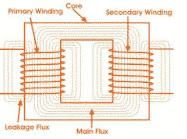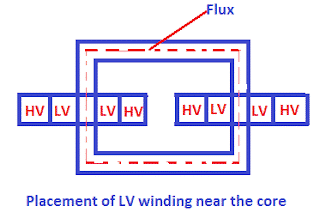The LV winding is placed next to the core because, with this arrangement, we get the advantage of reduced insulation, low leakage reactance, and easy placement of the tap changer at the outer HV winding.
First, let’s understand the basic concept so that we can understand why the LV winding is placed nearer to the core.
In a three-phase transformer, the primary and secondary winding are placed around the core. The cross-section area of the high-voltage winding conductor is less than that of the low-voltage winding, and to transfer the same power from primary to secondary, the voltage is stepped down at the secondary end. As a result, the current in the secondary will increase in the same proportion as the reduction of the secondary voltage.
For example – A transformer with a delta star configuration of rating 6.6/0.440 KV, 50 Hz, 1500 KVA,
The ratio of primary to secondary voltage (line-line)=6600/440= 15——— (i)
Primary line current Ip = 1500*1000/ √3 *6600 = 131 Amp.
The line current on the secondary side will be 15 times that of the line current in the primary because the voltage at the secondary is reduced by 1/15 times of the primary voltage, therefore the current at the secondary side of the transformer will increase by 15 times of the primary line current.
Line current at secondary side = 131 *15= 1965 Amp.
From the above example, it is clear that the current rating of the low-voltage side of the transformer is higher than the current at the high-voltage side.
Leakage reactance
When the primary winding of the transformer is connected to the supply, the current flowing in the primary winding produces a magnetic field and induces flux in the core. The flux travels through the magnetic core and links to the secondary winding. Practically, all of the flux produced in the primary does not link to the secondary, and the flux that does not link to the secondary is considered leakage flux.

The primary flux that does not link to the secondary is known as the leakage flux. The reason for the leakage inductance is that the flux between primary and secondary winding is not perfectly coupled. The flux produced in the primary does not link to every turn of the secondary, and some parts of the flux remain unlinked to the secondary and, it introduces leakage inductance in series with the primary and secondary winding of the transformer. The higher the leakage inductance is, the lower the regulation of the transformer.
Why is LV winding placed next to the core?
There are two reasons for placing the low-voltage winding nearer to the core.
Insulation Requirement:
In the concentric arrangement of placing HV and LV winding, less insulation is required when LV winding is placed near the core, which is at ground potential. The HV winding is placed around the LV. The HV winding is provided with a tap changer to maintain the desired voltage. If the high voltage(HV) winding is placed near the core, more insulation is needed to insulate the high voltage winding of the transformer and the core. The thicker insulation is required if the HV is placed near the core. For the same rating of transformer, if high voltage winding is placed near the core, more insulation will be required, and more insulation leads to an increase in the size and cost of the transformer.
If low-voltage winding is placed near the core, the size and cost of the transformer are reduced. In a core-type transformer, the LV winding is always placed near the core. In a shell-type transformer, HV and LV winding are interleaved alternately to reduce the leakage flux.
Let us understand the insulation requirement in the core-type transformer after the placement of winding in different ways.
Let the transformer voltage rating be 132/6.6 KV. The low-voltage winding is placed near the core, and the high-voltage winding is placed after LV placement.

How does the insulation requirement Increase with the change in the position of HV and LV winding?
Case 1: If LV winding is placed near the core
The insulation required for LV =
Insulation required to insulate LV and Core + Insulation required to insulate HV and LV winding.
The insulation required for LV = 6.6 + (132-6.6) =132 KV
Case 2: If HV winding is placed near the core
The insulation required for HV =
Insulation required to insulate HV and Core + Insulation required to insulate HV and LV winding
The insulation required for HV = 132 + (132-6.6) =257 KV
Percentage increase in insulation = (257-132)/132 x 100 = 94.69 %
Thus, the increase in insulation results in an increase in the cost and size of the transformer.
Low Leakage Reactance:
The leakage reactance depends on the distance between the core and the HV winding. When the HV winding is placed farthest from the core, the leakage reactance of the primary is low. The low leakage reactance means most of the flux produced in the primary winding gets linked to the secondary. The inrush current of the transformer gets reduced. Furthermore, the voltage regulation of the transformer is improved.
Placement of Tap Changer on HV side
The tap changer is placed on the high-voltage side of the transformer. The current flowing in the HV winding is low; hence, there is less wear on the tap changer contacts. Also, it is easy to bring the connections of the HV winding at the tap changer because the cross-section area of the connecting lead is less. If the tap changer is connected to the LV side of the transformer, a large cross-section area conductor is needed, and there would be more contact wear of the tap changer contact because of more current. Thus, placing the low voltage winding near the core and high voltage winding after low voltage winding facilitates ease of tap changer connections at high voltage winding, and thus, the longer the life of the transformer tap changer can be achieved.